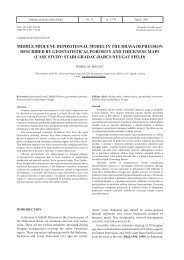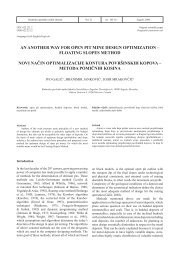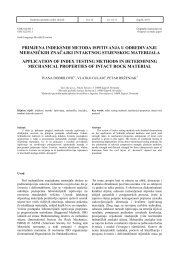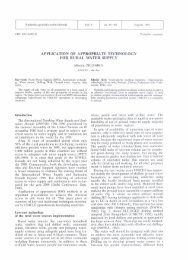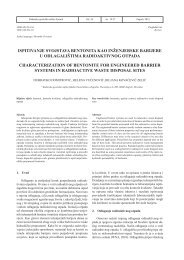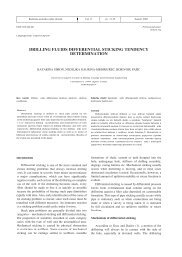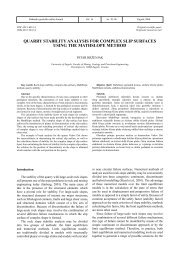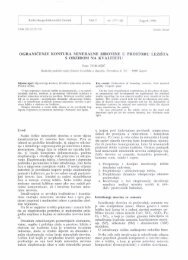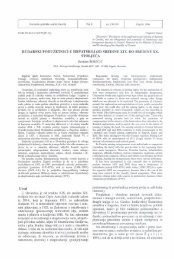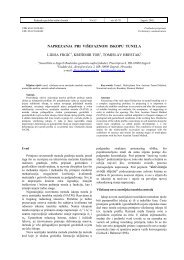continuum and discontinuum modelling in tunnel engineering
continuum and discontinuum modelling in tunnel engineering
continuum and discontinuum modelling in tunnel engineering
You also want an ePaper? Increase the reach of your titles
YUMPU automatically turns print PDFs into web optimized ePapers that Google loves.
Rud.-geol.-naft. zb., Vol. 12, Zagreb, 2000.50 Burlu, G., Burlu M.: Cont<strong>in</strong>uum <strong>and</strong> dis<strong>cont<strong>in</strong>uum</strong> <strong>modell<strong>in</strong>g</strong>ElFigure 10. Pont Ventoux - Clarea F2 <strong>tunnel</strong>Model Bolts n. Bolt lenght Bolt spac<strong>in</strong>g(') Schortcrete thickness(')~olts are supposed to be <strong>in</strong>stalled accord<strong>in</strong>g to a square patternThe bolts were simulated by us<strong>in</strong>g the CABLE optionavailable with<strong>in</strong> the UDEC code, which allows one toconsider a bolt fully bonded to the rock mass. The shot-Crete was <strong>in</strong>troduced <strong>in</strong> the model by the STRUCToption which consists <strong>in</strong> simulat<strong>in</strong>g it as a series of beamsconnected to the rock mass.As a first estimate of the predictive capability of theUDEC dis<strong>cont<strong>in</strong>uum</strong> <strong>modell<strong>in</strong>g</strong> of the supported <strong>tunnel</strong>the attention is posed on compar<strong>in</strong>g the verfical <strong>and</strong>horizontal displacements Av <strong>and</strong> Ah given by the empiricalQ based formulae reported above <strong>and</strong> the results ofUDEC computations:Model233. Case studyAv [mm]Ah [mm]estimated-computed estimated-computed4.5- 5.0 2.6- 2.69.2-10.2 4.7- 5.33.1. Background <strong>in</strong>formationThe case study considers the problems occurred on 11September 1997, at ch 2360 m, when cross<strong>in</strong>g a fault zonewhich caused the TBM to become temporarily stuckdur<strong>in</strong>g excavation of the F2 <strong>tunnel</strong>, one of the majorelement of the Pont Ventoux- Susa Hydropower Project<strong>in</strong> the Susa Valley, near Tor<strong>in</strong>o. This <strong>tunnel</strong> (4.75 mdiameter) is be<strong>in</strong>g excavated by an open TBM configurationthrough uartzitic micaschists under a coverwhich is to reach 'B 00 m maximum (Figure 10).Follow<strong>in</strong>g the first 1800 m approximately where therock mass conditions where generally good, with RMRvalues rang<strong>in</strong>g from 65 to 75 (Figure ll), TBM <strong>tunnel</strong>l<strong>in</strong>g<strong>in</strong> the F2 <strong>tunnel</strong> became progressively more severewith the approach<strong>in</strong>g of the fault zone. At present, the<strong>tunnel</strong> is experienc<strong>in</strong>g very severe dificulties with consid-Figure 1 I. A view of the F2 <strong>tunnel</strong> <strong>in</strong> the section where the gneiss rockmuss was generally gooderable delays with respect to the expected advance rate.Figure 12 shows two photographs taken follow<strong>in</strong>g cha<strong>in</strong>age2360 m, where the fault of <strong>in</strong>terest <strong>in</strong> this papercrossed the <strong>tunnel</strong>, affect<strong>in</strong>g progress significantly.3.2. Description of the overstress problem at ch 2360 mThe sketch shown <strong>in</strong> Figure 13 gives a simplified illustrationof the conditions at the <strong>tunnel</strong> face where theTBM became temporarily stuck as a consequence ofoverstress<strong>in</strong>g <strong>and</strong> a 25 cm block movement of the rightsidewall (Figure 14). The quartzitic micaschist is chara~terized by the presence of three to four jo<strong>in</strong>t systems<strong>in</strong>clud<strong>in</strong>g foliation. Based on geologic mapp<strong>in</strong>g, whichwas carried out by the contractor's geologist (Pont Ventoux,1997) once the TBM could drill a few meters aheadof the section where it jammed (Figure 15), at least twosub-parallel discont<strong>in</strong>uities could be evidenced, the secondof which (a fault with stnke N66E <strong>and</strong> dip 83 to theS, which <strong>in</strong>tercepts the <strong>tunnel</strong> axis) has a clay fill<strong>in</strong>g <strong>and</strong>gouge with aperture rang<strong>in</strong>g from a few centimeters tomore than a decimeter.The rock mass conditions were estimated on a 7 rn<strong>tunnel</strong> length, from ch 2349 to ch 2356 m, with RMR<strong>in</strong>dex equal to 31. Accord<strong>in</strong>g to a more complete Q-logg<strong>in</strong>gestimate due to Barton (1997), from ch 2350 to ch



